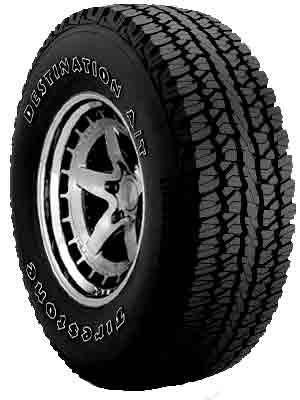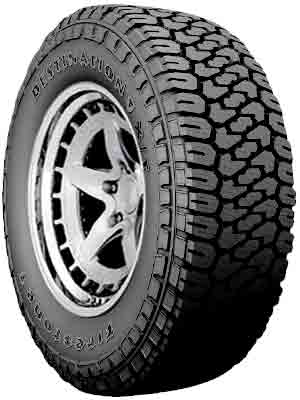Firestone Destination AT vs XT: Both of the under-discussion tires are all terrain, developed for drivers who want to go anywhere dependably. XT has greater void ratio compared with AT, which decreases its contact patch, making it best suited for off-roading.
While AT has greater contact patch, making it superior for on-road driving.

Examine the treads on these tires closely. They hold the key to knowing which to choose. In fact if you visit my "tread design" page, picking the right tire would never bother you.
The higher built strength and the open tread design of XT boost its off-road capabilities.
Table of Contents
Comparing Firestone Destination AT
Firestone Destination A/T

Firestone Destination X/T


Vs

The Firestone Destination AT tires have center rib flanked by independent intermediate blocks and wrap around shoulders that combine highway stability with off-road traction.
Increased contact patch improves its traction while on-road and deep sipes improve wet traction.
Narrower grooves are not efficient in soft snow, mud, and gravel traction as they can’t maintain grip.
The closed shoulder design further hinders the flow of mud through its grooves.
The higher contact is, however, useful on icy roads as it allows the tire to firmly grasp the road, increasing its traction on ice.
The tire has weaker built which doesn’t allow the tire to perform well on rocks as it is vulnerable to trail damages like cuts and chips.
The small stone ejectors are also unable to keep all the stones from getting stuck inside the grooves.
This decreases the dependency of this tire on rocks.
Since the tire has weaker built, it is unable to resist wear and tear, decreasing the tire’s durability and mileage.
The tire is comfortable on-road due to lower noise level but is not reliable off-road due to inability to withstand jerks.
The Firestone Destination XT, on the other hand, has specially formulated rubber compound molded into an aggressive symmetric pattern.
The higher void ratio allows less contact with the road, making its on-road traction inferior to AT.
Its void ratio is higher plus it has deeper sipes.
The higher tread depth and the numerous sipes help to wipe water easily.
The wider grooves help to remove mud and snow effortlessly through its tread.
The aggressive off-shoulder tread design creates a biting edge with mud and snow condition, it also helps with mud passing through its grooves.
Destination XT is certified with severe snow service rated and is branded with the three-peak mountain snowflake (3PMSF) symbol but lacks on ice due to the absence of a decent contact patch, making it slip.
The higher build quality increases its treadwear resistance which in turn improves its durability and mileage.
The tire is noisier on road but dampens the impact of shocks to provide a comfortable off-road journey.
On-Road traction comparison:
Destination AT has a lower void ratio that allows decent contact patch.
As it has good contact patch so its dry grip is enhanced as more of the part is touching the road improving the grip and providing a controlled driving experience.
It provides good wet traction but not as good as its rival due to the lack of sipes as well as narrow grooves.
The higher void ratio of Destination XT results in lower contact patch, making it unfavorable for on-road traction as compared to AT.
However, on wet roads, greater void ratio along with deep sipes easily wipe away the water, providing better grip.
Off-Road traction comparison:
Destination AT has smaller void ratio, making it less effective in mud conditions.
The narrow grooves don’t allow easy navigation through the mud because the mud gets stuck inside them, decreasing its performance.
Shoulder design used in AT is less optimized which further hinders the traction of mud, making it an undesirable tire on mud terrain.
The increased void percentage of Destination XT allows smooth steering through mud by efficiently tossing particles backward with aid of wider grooves.
Aggressive tread pattern and open shoulder design assist in clearing the mud from the tread.
Its shoulder design increases the biting strength needed to move through deep mud, providing it a great advantage over mud terrains.
Same is the case with Snow.
If we talk about the tires performance on rocks/gravels, the again the Destination AT with less groove voids provide lesser grip on rocks.
Stone ejectors are not quite efficient which makes the tire less effective from stopping the stones from getting into the tread.
Protection against pebbles/stones is also not satisfactory, decreasing the credibility of the tire on rocks.
Destination XT on the other hand, with its aggressive pattern provides biting edges which help to crawl on rocks.
Stone ejectors in this tire are effective at stopping the stones from getting into the tread.
The thick sidewall protector shoulder helps the tire to counter impacts and provide shield from cuts, making it a more attractive option for rocks traction.
Comfort level:
Destination XT has greater void ratio and more particles of air get trapped into it and collide with its walls, producing noise and compromising the comfort level during on-road travel. Whereas, during off-roading, the open tread pattern helps to absorb shocks, making the journey comfortable.
In comparison, AT is less noisy as compared to Destination XT because of the lower void ratio which causes a lower number of air particles to get stuck inside grooves, producing lesser noise while moving at high speed, making it more comfortable on-road But during off-road traction, the comfort level is compromised because of the inability to narrow grooves to absorb shocks efficiently.
Durability and treadwear:
Destination AT has higher contact patch increasing its rolling resistance and decreasing the force needed to keep the vehicle moving. Because of more rolling resistance, the treadwear is high as well which indirectly proportional to durability. AT consists two-ply polyester string casing which supports two high-tensile steel belts. A nylon reinforcement ply provides durability and higher speed capability.
Destination XT has the lower contact patch with the road because of the higher void ratio decreasing its rolling resistance. Because of lower rolling resistance, the wearing of tread is also lower, increasing the tire’s durability. XT interior structure includes twin, high-tensile steel cord belts reinforced with spirally wrapped nylon on top of a polyester cord casing to combine strength, durability, and ride comfort.
Last Words:
- AT is better on road
- XT is good at off roading than its rival
- XT performs good in mud/snow compared with its counterpart.
- The durability of XT better as compared to AT.
- XT costs more due to its better off road capabilities.








